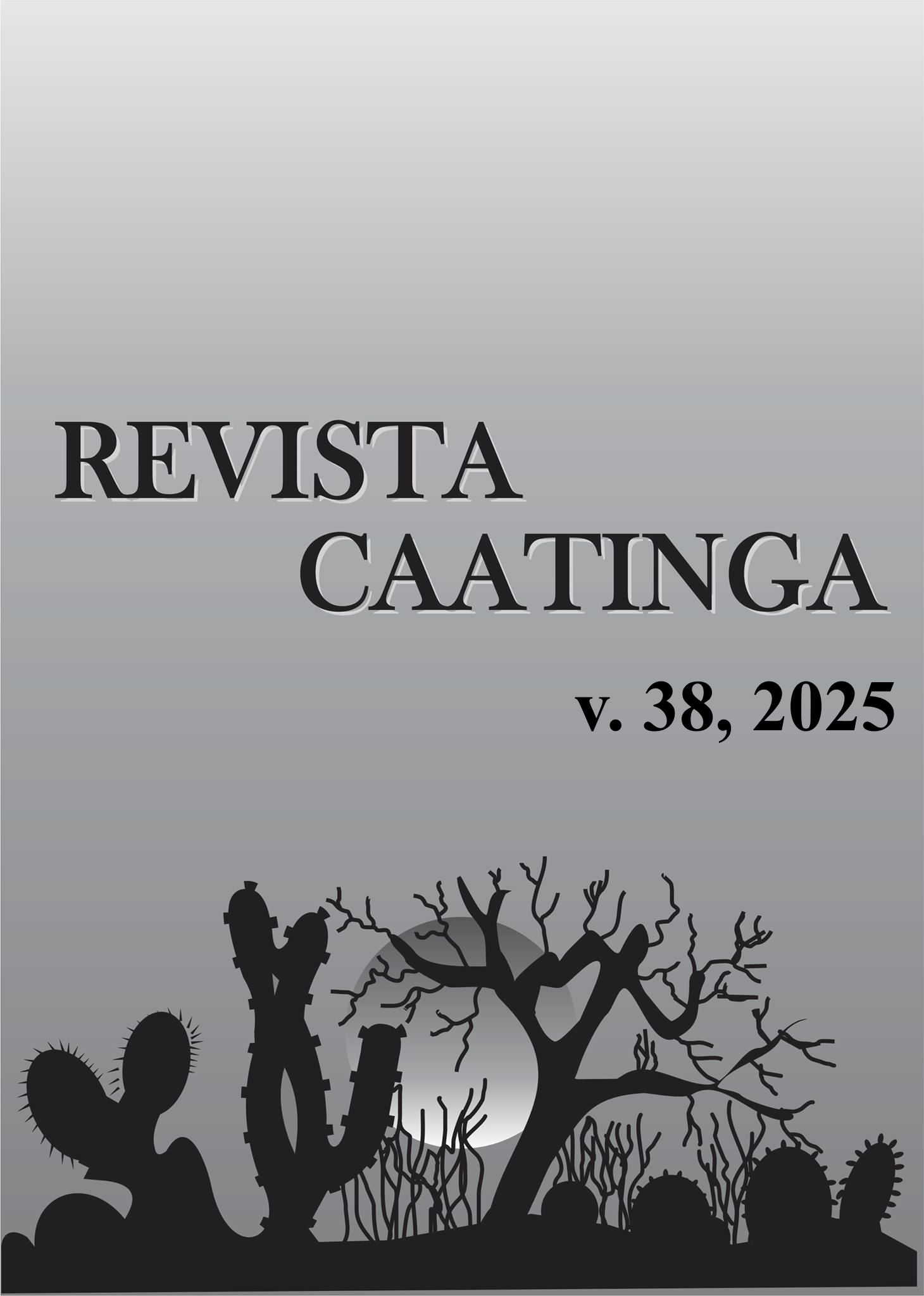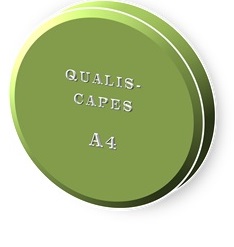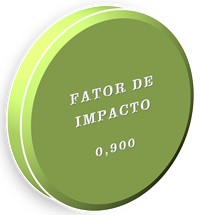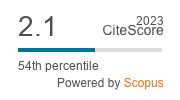Growth and solute accumulation in collard greens after pre-treatment with H2O2 under salt stress
DOI:
https://doi.org/10.1590/1983-21252025v3812861rcKeywords:
Brassica oleracea. Salinity. ROS. Biomass production.Abstract
Hydrogen peroxide (H2O2) acts as a signaling molecule inducing increased plant tolerance to stress conditions. The objective of the present study was to evaluate the effect of pre-treatment with H2O2 as a possible attenuator of salt stress on the production of biomass and organic and inorganic solutes in collard greens under salt stress. The plants were grown under hydroponic conditions in a greenhouse. The experimental design used was completely randomized with eight replications with the combination of three times of exposure to H2O2 (12, 24, and 36 h) and four levels of H2O2 in the pre-treatment solution (0.1, 1.0, 10, and 100 µM). Two control treatments were added, one without the presence of NaCl and another with the presence of 100 mM NaCl, both without pre-treatment with H2O2. After 60 days of assay the plants were collected and subsequently analyzed. Salinity affected collard green biomass production regardless of the concentration and time of exposure to H2O2. Salinity reduced biomass production in collard greens and there was an increase in Na+ and Cl-, while K+ decreased, but pre-treatment with H2O2 proved to be effective in increasing the levels of organic solutes, highlighting the importance of H2O2 in the plant's adaptive response.
Downloads
References
ALVARES, C. A. et al. Köppen’s climate classification map for Brazil. Meteorologische Zeitschrift, 22: 711-728, 2013.
AZEVEDO NETO, A. D. et al. Selection of sunflower genotypes for salt stress and mechanisms of salt tolerance in contrasting genotypes. Ciência e Agrotecnologia, 44: e020120, 2020.
AZEVEDO NETO, A. D.; SILVA, E. C.; Physiology and biochemistry of salt stress tolerance in plants. In: CHAKRABORTY, U.; CHAKRABORTY B. (Eds.). Abiotic stresses in crop plants. Wallingford: CABI, 2015. v. 1, cap. 6, p. 81-101.
BATISTA-SILVA, W. et al. The role of amino acid metabolism during abiotic stress release. Plant, Cell & Environment, 42: 1630-1644, 2019.
BRADFORD, M. M. A rapid and sensitive method for the quantification of microgram quantities of protein utilizing the principle of protein-dye binding. Analytical Biochemistry, 72: 246-254, 1976.
COSTA, L. F. D. et al. Cauliflower growth and yield in a hydroponic system with brackish water. Revista Caatinga, 33: 1060-1070, 2020.
COVA, A. M. W. et al. Effect of salt stress on growth and contents of organic and inorganic compounds in noni (Morinda citrifolia L.). African Journal of Biotechnology, 15: 2401-2410, 2016.
COVA, A. M. W. et al. Content of inorganic solutes in lettuce grown with brackish water in different hydroponic systems. Revista Brasileira de Engenharia Agrícola e Ambiental, 21: 150-155, 2017.
DANTAS, M. V. et al. Gas exchange and hydroponic production of zucchini under salt stress and H2O2 application. Revista Caatinga, 35: 436-449, 2022.
DUBOIS, M. et al. Colorimetric method for determination of sugars and related substances. Analytical Chemistry, 28: 350-356, 1956.
FURLANI, P. R. Instrução para o cultivo de hortaliça de folha pela técnica de hidroponia – NFT. Campinas, SP: Instituto Agronômico, 1998. 30 p. (Boletim Técnico, 168).
GAINES, T. P.; PARKER, M. B.; GASCHO, G. J. Automated determination of chlorides in soil and plant tissue by sodium nitrate. Agronomy Journal, 76: 371-374, 1984.
INMET - Instituto Nacional de Meteorologia. Dados históricos anuais. Available at:< https://portal.inmet.gov.br/dadoshistoricos>. Access on: Apr. 19, 2023.
IULIANELLI, G. C. V. et al. Sopa de alimentos funcionais–propicia o aumento da imunidade defesa contra a ação do COVID-19. Functional foods soup-provides immunity boosting defense against the action of COVID-19. Brazilian Journal of Development, 7: 59173-59179, 2021.
JONES JUNIOR, B. Laboratory guide for conducting soil tests and plant analysis. Boca Raton: CRC, 2001, 384 p.
MIRANDA, R. S. et al. Integrative control between proton pumps and SOS1 antiporters in roots is crucial for maintaining low Na+ accumulation and salt tolerance in ammonium supplied Sorghum bicolor. Plant Cell Physiology, 58: 522-536, 2017.
NOBOA, C. S. et al. Produção hidropônica e análise sensorial de couve-de-folhas na forma de maço de plantas jovens. Revista Ciência, Tecnologia & Ambiente, 9: e09121, 2019.
Ó, L. M. G. et al. Aspectos bioquímicos e fluorescência da clorofila a em plantas de minimelancia hidropônica sob estresse salino. Irriga, 26: 221-239, 2021.
PURQUERIO, L. F. V. et al. Bioeconomia: promoção da horticultura urbana do século XXI. O Agronômico, 70: 6-19, 2018.
R DEVELOPMENT CORE TEAM. R: A language and environment for statistical computing. Vienna: R Foundation for Statistical Computing, 2022. Versão 4.4.2. Available at: <https://www.R-project.org/>. Access on: Jan. 25, 2025.
ŠAMEC, D.; LINIĆ, I.; SALOPEK-SONDI, B. Salinity stress as an elicitor for phytochemicals and minerals accumulation in selected leafy vegetables of Brassicaceae. Agronomy, 11: 361, 2021.
SILVA, M. G. et al. Evaluation of salt and root-zone temperature stresses in leafy vegetables using hydroponics as a clean production cultivation technique in northeastern Brazil. Horticulture, Environment, and Biotechnology, 65: 95-118, 2024.
SILVA, M. G. et al. Growth and yield of cauliflower with brackish waters under hydroponic conditions. Revista Brasileira de Engenharia Agrícola e Ambiental. 27: 663-672, 2023a.
SILVA, P. C. C. et al. Avaliação de métodos de aplicação de H2O2 para aclimatação de plantas de girassol à salinidade. Water Resources and Irrigation Management, 8: 1-4, 2019.
SILVA, P. C. C. et al. Hydrogen peroxide (H2O2) improves ion homeostasis in coriander plants under salt stress. Revista Brasileira de Engenharia Agrícola e Ambiental, 27: 729-735, 2023b.
SILVA, P. C. C. et al. Salt tolerance induced by hydrogen peroxide priming on seed is related to improvement of ion homeostasis and antioxidative defense in sunflower plants. Journal of Plant Nutrition, 44: 1207-1221, 2020.
SILVA, P. C. C. et al. Seed priming with hydrogen peroxide enhances tolerance to salt stress of hydroponic lettuce. Revista Brasileira de Engenharia Agrícola e Ambiental, 27: 704-711, 2023c.
TAVARES-JÚNIOR, J. E. et al. Análise comparativa de métodos de estimativa de área foliar em cafeeiro. Bragantia, 61: 199-203, 2002.
YEMM, E. W.; COCKING, E. C. The determination of amino-acids with ninhydrin. Analyst, 80: 209-2013, 1955.
Downloads
Published
Issue
Section
License
Os Autores que publicam na Revista Caatinga concordam com os seguintes termos:
a) Os Autores mantêm os direitos autorais e concedem à revista o direito de primeira publicação, com o trabalho simultaneamente licenciado sob a Licença Creative Commons do tipo atribuição CC-BY, para todo o conteúdo do periódico, exceto onde estiver identificado, que permite o compartilhamento do trabalho com reconhecimento da autoria e publicação inicial nesta revista, sem fins comerciais.
b) Os Autores têm autorização para distribuição não-exclusiva da versão do trabalho publicada nesta revista (ex.: publicar em repositório institucional ou como capítulo de livro), com reconhecimento de autoria e publicação inicial nesta revista.
c) Os Autores têm permissão e são estimulados a publicar e distribuir seu trabalho online (ex.: em repositórios institucionais ou na sua página pessoal) a qualquer ponto antes ou durante o processo editorial, já que isso pode gerar alterações produtivas, bem como aumentar o impacto e a citação do trabalho publicado (Veja O Efeito do Acesso Livre).







